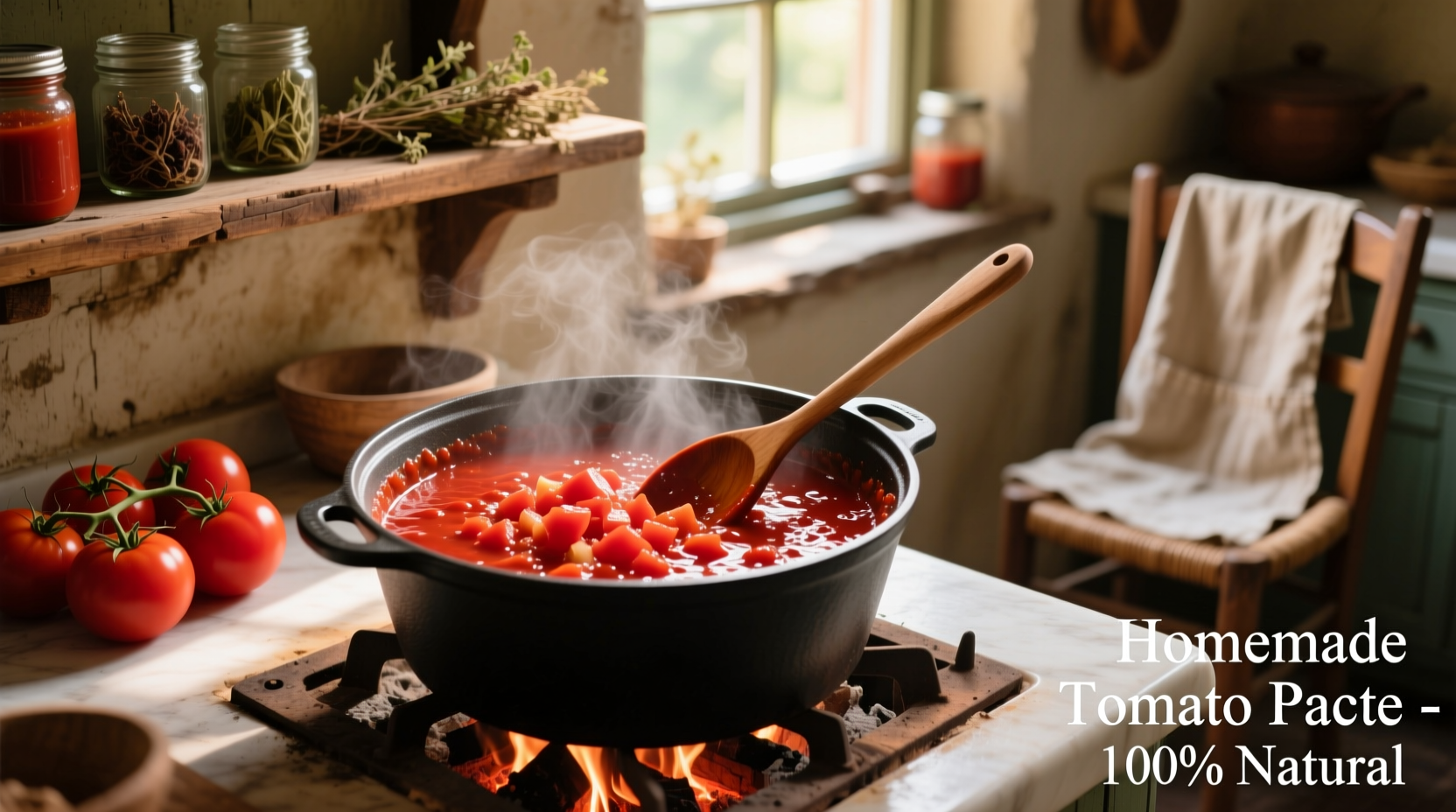Yes, you can easily make rich, flavorful tomato paste at home using fresh tomatoes, basic kitchen equipment, and 4-6 hours of simmering time. Homemade paste contains no preservatives, costs up to 60% less than store-bought versions, and delivers superior depth of flavor compared to commercial products.
Your Complete Guide to Crafting Perfect Homemade Tomato Paste
There's nothing quite like the deep, concentrated flavor of tomato paste made from garden-fresh produce. As someone who's taught thousands of home cooks professional preservation techniques, I've found that making tomato paste at home isn't just economical—it transforms how you experience Italian, Mediterranean, and Latin American cuisines. Forget the metallic aftertaste of canned versions; your homemade paste will elevate sauces, soups, and stews with pure tomato essence.
Why Homemade Beats Store-Bought Every Time
Commercial tomato paste often contains citric acid, calcium chloride, and other preservatives to extend shelf life. When you make your own, you control every ingredient. The flavor difference is remarkable—homemade paste delivers a bright, fresh tomato profile that intensifies dishes without unwanted chemical notes. Plus, you'll save significantly: processing 10 pounds of tomatoes (costing about $15 at farmers' markets) yields approximately 1.5 cups of paste—equivalent to six $3.50 store-bought tubes.
| Characteristic | Homemade Paste | Store-Bought Paste |
|---|---|---|
| Ingredients | Tomatoes only | Tomatoes, citric acid, calcium chloride |
| Cost per ounce | $0.83 | $2.20 |
| Flavor profile | Bright, complex, fresh | Metallic, one-dimensional |
| Shelf life (refrigerated) | 3 weeks | 4-6 weeks |
Essential Equipment Checklist
You don't need specialized gear, but these items make the process efficient:
- Large stainless steel pot (8-10 quart capacity)
- Food mill or fine-mesh strainer
- Wooden spoon (avoid metal which can react with acids)
- Dehydrator (optional for shelf-stable version)
- Freezer-safe containers or canning jars
Selecting the Perfect Tomatoes
Roma (plum) tomatoes are ideal for paste making due to their low moisture content and high flesh-to-seed ratio. According to USDA agricultural research, Romas contain approximately 5.8% solids compared to 4.2% in standard slicing tomatoes—meaning less water to evaporate during cooking. If Romas aren't available, opt for other paste varieties like San Marzano or Amish Paste. Avoid watery beefsteak tomatoes which require significantly longer reduction times.

The Step-by-Step Process
Preparation Phase (30 minutes)
- Wash 10 pounds of tomatoes thoroughly
- Cut out cores and make shallow "X" incisions on the bottom of each
- Blanch in boiling water for 60 seconds, then transfer to ice bath
- Peel off skins (they should slip off easily)
- Quarter tomatoes and remove seeds using a spoon
Cooking Timeline (4-6 hours)
| Time Elapsed | Visual Cues | Required Action |
|---|---|---|
| 0-60 minutes | Tomatoes release liquid, bubbling vigorously | Stir occasionally, maintain medium simmer |
| 1-3 hours | Liquid reduces by half, mixture thickens slightly | Stir every 20 minutes, reduce heat to low |
| 3-5 hours | Deep red color, paste coats spoon | Stir every 10 minutes, watch for sticking |
| 5-6 hours | Paste mounds when dropped from spoon | Remove from heat immediately |
The critical moment arrives when the paste reaches "sheeting" stage—when a spoonful dropped into a bowl forms a mound rather than spreading. This indicates proper concentration (approximately 24-28% solids content, matching commercial standards). Overcooking creates bitter, caramelized flavors; undercooking yields a sauce rather than paste.
Safe Storage Methods
Proper preservation ensures your hard work lasts. The National Center for Home Food Preservation recommends these methods:
- Refrigeration: Store in airtight container for up to 3 weeks
- Freezing: Portion into ice cube trays, then transfer to freezer bags (6 months)
- Canning: Process pints in a boiling water bath for 15 minutes (12 months)
- Dehydrating: Spread thin on silicone mats, dehydrate at 135°F until brittle (2 years)
Important safety note: Never can tomato paste without added acid. The FDA requires adding 1 tablespoon lemon juice or 1/4 teaspoon citric acid per pint to ensure safe pH levels below 4.6, preventing botulism risk.
When Homemade Makes Sense (and When It Doesn't)
While homemade paste shines in most applications, understand these context boundaries:
- Choose homemade when: Making Sunday gravy, pizza sauce, or any dish where tomato flavor is central
- Use store-bought when: Creating quick weeknight meals with tight time constraints
- Best compromise: Freeze homemade paste in tablespoon portions for instant use
Troubleshooting Common Issues
Problem: Paste tastes bitter
Solution: You likely caramelized the sugars during final reduction. Next time maintain lower heat during last hour and stir more frequently.
Problem: Paste separates in storage
Solution: Insufficient reduction. Simmer longer until it passes the "sheeting" test described earlier.
Problem: Mold develops in refrigerated paste
Solution: Contamination occurred during storage. Always use clean utensils when scooping and keep surface level smooth to prevent air exposure.
Culinary Applications That Shine
Your homemade paste will transform these dishes:
- Base for authentic Neapolitan pizza sauce (just paste + salt)
- Depth enhancer for French onion soup
- Secret ingredient in beef bourguignon
- Flavor booster for roasted vegetable dishes
Professional chefs typically use a 1:3 ratio of homemade paste to liquid when substituting for canned versions, as the concentration is higher without added water.
Seasonal Considerations
Tomato quality varies significantly by season. According to agricultural studies from the University of California, peak flavor compounds develop when tomatoes ripen at temperatures between 70-75°F with ample sunlight. This typically occurs from July through September in most temperate climates. Off-season tomatoes often lack sufficient natural sugars for optimal paste, requiring longer cooking times and yielding less vibrant flavor.











 浙公网安备
33010002000092号
浙公网安备
33010002000092号 浙B2-20120091-4
浙B2-20120091-4